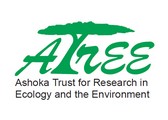Any and all opinions expressed in this newsletter are solely those of the author(s) and do not reflect the opinion of ATREE.
Centre for Excellence in Conservation Science
Royal Enclave,Srirampura,Jakkur Post
Bangalore-560064
Telephone: 080-23635555 (EPABX)
Fax : 080- 23530070
The landscape of Tirunelveli district makes a perfect painting with the Agasthyamalai hills in the backdrop, agricultural fields and wetlands in the foothills interspersed with Palmyra trees. The agricultural fields and wetlands are adorned by hundreds of colorful water birds like the storks, pelicans, herons, jacanas, ibises and egrets which is a sight to behold.The district has no dearth of water thanks to the many rivers that originate in the Agasthyamalai hills. Numerous human- made wetlands situated in the arid plains of the district are fed by perennial rivers viz., Tamiraparani, Manimuthar, Pachaiyar, Kodumudiyar, Gadananathi, Ramanathiand Nambiar through the river-canal-tank network. The matrix of wetlands surrounded by extensive paddy fields supports high diversity of waders, divers and shorebirds, most of which are winter migrants. The old trees and plantations support heronries while the palmyra traditionally planted around the tanks offer roosting sites for numerous resident birds. But there is little documented information on the bird life, their status and the threats these habitats are facing.As part of the wetland survey project funded by IUCN, all the tanks that lie in the buffer area of Kalakad Mundanthurai Tiger Reserve (KMTR) were surveyed by us to investigate the bird life in the region. Survey of India topographic sheets were used to trace the tanks which also gave us information of tanks that do not exist anymore. About 177 wetlands that lie within 5 km of the eastern boundary of KMTR spread over a distance of 65 km were surveyed between Nov 2008 and Feb 2009. This gave us an opportunity to also visit the tanks that may not be of use to the local population but were good habitat for birds. During the survey more than 13,164 birds belonging to 68 species were recorded.
Seventeen tanks that were found to support a large population of water birds were identified. These tanks were monitored seasonally to further investigate the importance of these tanks.This survey led us to Vaagaikulam tank situated at Nanalkulam near Alwarkurchi in Tirunelveli district which was found to sustain high bird diversity and was first reported by us. It is one of the largest heronries in the district of Tirunelveli after Koonthankulam bird sanctuary. The tank comprises of semi submerged karuvel trees and is an important nesting and roosting site for several non-migratory species of birds like black-crowned night heron, black-headed ibis, little cormorant, little egret and Indian pond heron. Unfortunately this heronry is in imminent danger as the trees that are currently used for nesting are scheduled to be cut down by the local authority.
The survey also showed that traditional methods of land use are slowly eroding which is resulting in degradation of the environment. We observed that the tank area is shrinking and in extreme scenarios entire tanks are disappearing due to landfills for development and encroachment of lake beds by current agricultural practices. This in turn is endangering the bird life that sustains this habitat. Therefore it is imperative to preserve and conserve what is left by protecting few of these tanks and educating people about the importance of birds. It is necessary to take up planting programs within the tank and its periphery. In small tanks, such plantations should be limited to a portion of the tank so that rest of the tank is left open to be used by ducks and other swimming birds and also for human activities like fishing and domestic purpose. Traditional practices of protecting the tanks where the community was completely engaged are fast eroding which needs to be revitalized wherever possible.
Editorial Team
Editor: Allwin Jesudasan
Associate editor: Rajkamal Goswami
Editorial Review: R. Ganesan, M. Soubadra Devy, T. Ganesh
Design and presentation: Kiran Salagame
A S H O K A T R U S T F O R R E S E A R C H I N E C O L O G Y A N D T H E E
N V I R O N M E N T
If you have any suggestions or comments please let us know through the boxes below






